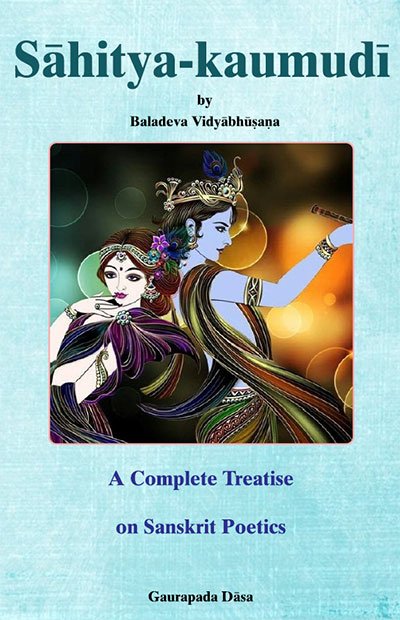Sahitya-kaumudi by Baladeva Vidyabhushana
by Gaurapada Dāsa | 2015 | 234,703 words
Baladeva Vidyabhusana’s Sahitya-kaumudi covers all aspects of poetical theory except the topic of dramaturgy. All the definitions of poetical concepts are taken from Mammata’s Kavya-prakasha, the most authoritative work on Sanskrit poetical rhetoric. Baladeva Vidyabhushana added the eleventh chapter, where he expounds additional ornaments from Visv...
Text 1.9
yathā,
यथा,
This verse illustrates excellent poetry (dhvani-kāvya):
muktāvalī niśi mayā dayitā kadambavāṭī-kuṭīra-kuhare sakhi vismṛtāsti |
tām āhareti vṛṣabhānujayā niyuktā tāṃ projjhya kiṃ śaśikale gṛham āgatāsi ||
muktā-āvalī—a row of pearls; niśi—at night; mayā—by Me; dayitā—dear; kadamba—of kadamba trees; vāṭī—in a garden; kuṭīra—in a cottage; kuhare—in a deep place; sakhi—O confidante; vismṛtā asti—has been forgotten; tām āhara—bring it; iti—(end of quotation); vṛṣabhānujayā—by Vṛṣabhānujā; niyuktā—who were appointed; tām—Her; projjhya—after forsaking; kim—why; śaśikale—O Śaśikalā; gṛham—home; āgatā asi—have you come.
[Lalitā talks to a gopī:] Śaśikalā, how is it that you came back home by forsaking Vṛṣabhānujā, who had entrusted you with a task: “Dear sakhī, last night I forgot My precious pearl necklace in a faraway place in the cottage in the arbor of kadamba trees. Kindly bring it back”? (Ujjvala-nīlamaṇi 8.68)
atra kṛṣṇāṅga-saṅgānubhavāyaiva tathā tvaṃ pratārya preṣitā na punar mauktika-hārāharaṇāya, yan nakhāṅka-śaśikalāñcita-vakṣoja-śambhuḥ samāgatāsīti vyaṅgyasya vācyād aticārutvād uttamam idaṃ kāvyam.
This is first-rate poetry because the implied sense, which is as follows, is much more beautiful than the literal meaning, “You were sent to experience the contact of Kṛṣṇa’s limbs, not to retrieve the pearl necklace, because you have returned with moonlike curves (śaśikalā) in the form of nail marks on the śiva-liṅgas of your breasts.”
Commentary:
Rūpa Gosvāmī shows the verse to illustrate an instance where one sakhī pretends to send another sakhī for some task, but the real purpose is to make the latter sakhī take pleasure with Kṛṣṇa.[1] Here Lalitā speaks with irony.
